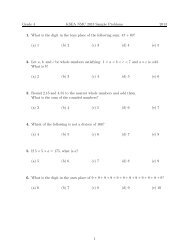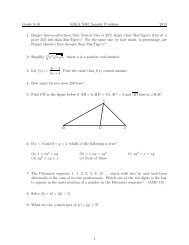Download KSEA Letters 40-3, Apr. 2012 [pdf] - Korean-American ...
Download KSEA Letters 40-3, Apr. 2012 [pdf] - Korean-American ...
Download KSEA Letters 40-3, Apr. 2012 [pdf] - Korean-American ...
Create successful ePaper yourself
Turn your PDF publications into a flip-book with our unique Google optimized e-Paper software.
FEATURED ARTICLES<br />
SINGLE MOLECULE BIOLOGY: ONE, TWO, THREE & FOUR<br />
[Taekjip Ha]<br />
Professor, Physics<br />
Center for the Physics of Living Cells, University of Illinois at Urbana-Champaign, Howard Hughes Medical Institute<br />
I call myself an accidental biophysicist. My Physics Ph.D work began in semiconductor physics and through a series of accidents I ended<br />
up developing methods to detect single fluorescence molecules. It turned out that the single molecule fluorescence methods could be<br />
applied to many biological systems and gradually my research topics shifted to biological questions, and although I teach physics in a<br />
physics department, all of the questions that we are addressing are biological in nature.<br />
Why would a physicist want to study biology? First, minimal functional units in biology are molecules and they can range between 1<br />
and 100 nm, the scale of current and future electronics. Second, biomolecules have been optimized through billions of years of evolution<br />
and often biological sensor reach the physical limits of sensitivity. A deep understanding of biological systems may ultimately lead<br />
to development of man-made nanomachines through reverse engineering. But is the population notion that biological molecules, for<br />
example proteins are nanomachines justified? For example, do the nanomachine have what man-made machines have such as engines<br />
and springs?<br />
The answer is a definitive yes for molecular motors that convert chemical energy stored in ATP or another high energy molecules into<br />
mechanical energy. A great example is myosin V which takes a 37 nm step along its track every time it consumes an ATP molecule as<br />
the fuel (Figure 1a). There was, however, a controversy as to whether myosin V walks on the track like a person (two feet alternating in<br />
position) or it crawls like a baby (one foot stays ahead of the other). Single molecule imaging and localization down to 1.5 nm precision<br />
led to a definitive proof that myosin V walks (1). This is an example of using detection of single fluorescent molecule to answer fundamental<br />
questions in biology (‘One’ in the title of this article).<br />
We recently made an exciting discovery that a protein can store elastic energy through multiple cycles of chemical energy release and<br />
that this stored energy can be released in a single burst (Gwangrog Lee et al., submitted). In this work, an enzyme that can digest RNA<br />
strand one base at a time even in the presence of basepaired structures was studied using another single molecule method called single<br />
molecule fluorescence resonance energy transfer (FRET). FRET measures the interaction between two dye molecules attached to a<br />
biological molecule and because FRET is a strong function of distance, it can report on even minute distance changes during biological<br />
reactions. In this particular work, we attached the dyes to the RNA so that FRET would increase during RNA unwinding by the enzyme<br />
(Figure 1b). The surprise was that the enzyme unwound RNA in large steps about 4 base pairs even though the motion is powered<br />
by RNA digestion in single base steps, strong suggesting the enzyme/RNA complex can be viewed as a spring. ‘Two’ in the title of this<br />
article refers to FRET and my laboratory has been fortunate to make several interesting discoveries on enzymes that work on DNA and<br />
RNA using the method.<br />
Figure 1. Protein as a nanomachine (a) A nanoengine.<br />
(b) A nano-spring.<br />
8<br />
<strong>KSEA</strong> LETTERS Vol. <strong>40</strong> No. 3 <strong>Apr</strong>il <strong>2012</strong>


![Download KSEA Letters 40-3, Apr. 2012 [pdf] - Korean-American ...](https://img.yumpu.com/23972233/10/500x640/download-ksea-letters-40-3-apr-2012-pdf-korean-american-.jpg)
![Download KSEA Letters 40-2, Jan. 2012 [pdf] - Korean-American ...](https://img.yumpu.com/23972281/1/190x245/download-ksea-letters-40-2-jan-2012-pdf-korean-american-.jpg?quality=85)
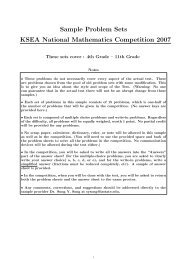
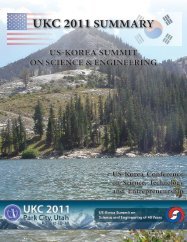

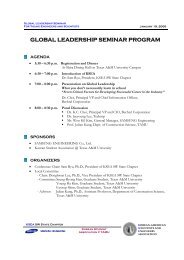
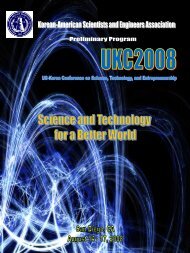
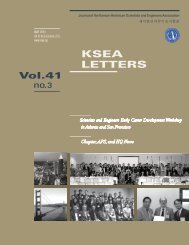


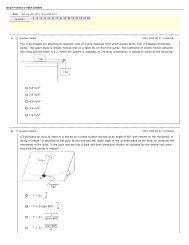
![Download KSEA Letters 40-4, Jun. 2012 [pdf] - Korean-American ...](https://img.yumpu.com/23972210/1/190x245/download-ksea-letters-40-4-jun-2012-pdf-korean-american-.jpg?quality=85)

